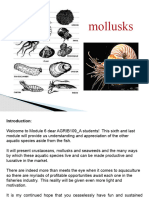Crayfish Dissection Lab
Crayfish Dissection Lab
Uploaded by
Kate FairleyCopyright:
Available Formats
Crayfish Dissection Lab
Crayfish Dissection Lab
Uploaded by
Kate FairleyOriginal Description:
Original Title
Copyright
Available Formats
Share this document
Did you find this document useful?
Is this content inappropriate?
Copyright:
Available Formats
Crayfish Dissection Lab
Crayfish Dissection Lab
Uploaded by
Kate FairleyCopyright:
Available Formats
Crayfish Dissection Lab Biology 11
Kate Fairley May 23 r d 2013 Block 4
Purpose: To observe and examine the anatomy of a crayfish Procedure:
1. Examine the external features of the crayfish. 2. Determine if the crayfish is male or female. 3. Remove then draw in a chart the following appendages from one side of the crayfish: antenna, antennule, mandible, jawfoot (maxilliped,) cheliped, walking leg, swimmeret, uropod and telson. Then in the same chart, name and describe the function of each appendage. 4. Cut the dorsal side of the crayfishs carapace from posterior to anterior then open it and identify the gills, heart, digestive glands, stomach and reproductive organs. 5. Cut open the stomach and observe the internal structures. 6. Remove one of the compound eyes and look at it under a dissecting microscope then sketch it.
Materials:
Dissection tray Scissors Probe
Tweezers Crayfish Dissecting microscope
Discussion:
1. a. A crayfishs digestive system consists of many parts. First, the food goes into the mouth and is crushed by the mandibles. From there, it goes into the stomach where chitinous teeth that line the stomach walls grind it down even further. The finest food particles are sent to the digestive gland for nutrient absorption. The mid-sized food particles are sent to the intestine where the indigested particles eventually come out the anus. b. The crayfish has such a short intestine because the vast majority of the nutrient absorption occurs in the digestive gland and therefore, less needs to occur in the
2.
3. 4.
5.
6. 7.
intestine. Also, because crayfish eat mostly animal matter, it takes less time to grind up and absorb the nutrients from their food. a. The gills of a crayfish are located on each of its walking legs. b. They are located on the legs because the legs move and in order to get fresh water near their gills so that they can breathe, they must be moving. Crayfish have adapted to have eyestalks because with an eyestalk, one can see a wider angle, making it easier to see predators and prey. a. The green gland acts as both a kidney and a bladder for the crayfish. It regulates the amount of salt and water in the blood and temporarily stores this waste. b. The green gland is located near the antennae because if it were located at the posterior end of the animal, the products that it excretes would be pushed into the creatures gills by the current. a. Crayfish are adapted to fresh water rather than marine habitats because they have green glands that control the amount of salt in their blood stream. b. Crayfish are adapted to fresh water rather than land habitats because they have gills rather than lungs. Crayfish antennae are used to sense: taste, touch and balance. All crustaceans have two pairs of antennae, chewing mouthparts, legs with claws, an exoskeleton and a segmented body.
Conclusion:
Crayfish have a digestive gland when they already have an intestine because the digestive gland secretes enzymes to further break down the food while the intestine does not. The crayfish had five pairs of legs but only four pairs that were used for walking. It also had four antennae, two antennules and two antennae. Our crayfish was male. The gills in the crayfish were attached to the legs. The crayfish had an open circulatory system; that means that in some places, the blood was allowed to pool around the organs. The stomach of the crayfish was lined with chitinous teeth that were used to grind up and sort the food in the stomach.
You might also like
- 1 Digestion in Teleost Fishes - 2Document23 pages1 Digestion in Teleost Fishes - 2Evi Nurul IhsanNo ratings yet
- External Parts of FishDocument18 pagesExternal Parts of FishHazel Leah KhaeNo ratings yet
- Tilapia Dissection and Guide: Lab Questions #1: Tilapia Belong To What Class of Bony Fish?Document9 pagesTilapia Dissection and Guide: Lab Questions #1: Tilapia Belong To What Class of Bony Fish?Alain Salvador100% (1)
- INTRODUCTIONDocument5 pagesINTRODUCTIONDivya BNo ratings yet
- Cuoi Ky 4106Document4 pagesCuoi Ky 4106Khoa NguyenNo ratings yet
- A6 N PDFDocument24 pagesA6 N PDFUmmesalma PatwegarNo ratings yet
- Fishery Arts Fishery Arts: Mrs. Sally C. SaldeDocument28 pagesFishery Arts Fishery Arts: Mrs. Sally C. SaldeJered Morato100% (1)
- TOPIC 6&7Document5 pagesTOPIC 6&7xgv2jtmk4jNo ratings yet
- Phagocytic - Role in DigestionDocument4 pagesPhagocytic - Role in Digestionchardz10No ratings yet
- GENBIO2_PeTa1Document5 pagesGENBIO2_PeTa1spreyes4231antNo ratings yet
- Fish Dissection - Student HandoutDocument4 pagesFish Dissection - Student Handoutntxmw8twdbNo ratings yet
- Chapter 30 ReviewDocument1 pageChapter 30 Reviewapi-444439435No ratings yet
- Practical 2 SheetDocument9 pagesPractical 2 SheetNur IzzatiNo ratings yet
- Bio ADocument3 pagesBio ADiosel Niño Jed EscarioNo ratings yet
- BIOL330 Lab 2 - Lab ManualDocument7 pagesBIOL330 Lab 2 - Lab ManualOliverNo ratings yet
- LESSON II: External Parts of Fish and Their FunctionsDocument32 pagesLESSON II: External Parts of Fish and Their FunctionsLourdicel De la RosaNo ratings yet
- Johnston Final Shrimp PosterDocument1 pageJohnston Final Shrimp Posterapi-300617862No ratings yet
- AnkiDocument6 pagesAnkisachaNo ratings yet
- (Cephalopoda) : Taxonomy of The CephalopodsDocument5 pages(Cephalopoda) : Taxonomy of The CephalopodsMetchie Rico RafaelNo ratings yet
- Microsoft Word - Dissection Dogfish LabDocument9 pagesMicrosoft Word - Dissection Dogfish Labapi-444439435No ratings yet
- Crayfish InfoDocument4 pagesCrayfish InfoDaniela Cordovez HidalgoNo ratings yet
- Biology of OysterDocument16 pagesBiology of OysterEugene SaldivarNo ratings yet
- Phylum EchinodermataDocument8 pagesPhylum EchinodermataLaraib Fatima Al HussainiNo ratings yet
- P.6 SCIE Lesson NotesDocument124 pagesP.6 SCIE Lesson NotesAnggik SyafaatNo ratings yet
- Snout Are Called Nostrils, or Nares.:: Have No FearDocument22 pagesSnout Are Called Nostrils, or Nares.:: Have No FearKristine Joy Eyao BalayoNo ratings yet
- Anatomy Nilem Fish and CatfishDocument18 pagesAnatomy Nilem Fish and CatfishDion Satrio PambudiNo ratings yet
- Fish DissectionDocument3 pagesFish DissectionVanessa Carolina Martinez Ahumada100% (2)
- Aquatic Mammal OrgansDocument6 pagesAquatic Mammal Organsallymaria04No ratings yet
- Laboratory Experiment 4Document8 pagesLaboratory Experiment 4auramariefijer1121No ratings yet
- Nutrition of Vertebrates Fish Amphibians Reptiles Birds MammalsDocument27 pagesNutrition of Vertebrates Fish Amphibians Reptiles Birds MammalsScribdTranslationsNo ratings yet
- EchinodermataDocument10 pagesEchinodermataapi-272860178No ratings yet
- Fish Culture: External & Internal Parts of Fish - Types of Fish Scales - Parts of GillsDocument55 pagesFish Culture: External & Internal Parts of Fish - Types of Fish Scales - Parts of Gillsbongsky1No ratings yet
- Frog DissectionDocument2 pagesFrog DissectionEmelinda CruzNo ratings yet
- Unit 5. InvertebratesDocument8 pagesUnit 5. InvertebratesYolanda Fernández VelascoNo ratings yet
- Introduction To VertebratesDocument16 pagesIntroduction To VertebratestzerchyanNo ratings yet
- Patricio SP Chanos ChanosDocument7 pagesPatricio SP Chanos ChanosKathleen Joy Partoza PlagataNo ratings yet
- CDU ZOOLOGY Anatomical Terminologies in Chordates and Vertebrates WorksheetDocument4 pagesCDU ZOOLOGY Anatomical Terminologies in Chordates and Vertebrates WorksheetKrisha Mae VillanuevaNo ratings yet
- MSF414 Term Paper - Evergreen OdehDocument6 pagesMSF414 Term Paper - Evergreen OdehEvergreen OdehNo ratings yet
- Special Chordate CharacteriscticsDocument19 pagesSpecial Chordate CharacteriscticsKunica SurajNo ratings yet
- PRACTICAL WORKSHEET ANATOMY 1 - International ClassDocument14 pagesPRACTICAL WORKSHEET ANATOMY 1 - International ClassPatPat GalaxyNo ratings yet
- Squid DissectionDocument3 pagesSquid Dissectionapi-297841438100% (1)
- AkuaDocument19 pagesAkuaFarhan ShabriNo ratings yet
- REPORT Practicum ZoologyDocument31 pagesREPORT Practicum ZoologyazizatulhaNo ratings yet
- Sean Burke - Online Crayfish DissectionDocument10 pagesSean Burke - Online Crayfish Dissectionapi-386190429No ratings yet
- Sub-Phylum Cephalochordata (Lancelets) : ObjectivesDocument5 pagesSub-Phylum Cephalochordata (Lancelets) : ObjectivesMiftah RohmahNo ratings yet
- Anatomy of FishDocument11 pagesAnatomy of FishrafumiNo ratings yet
- Important QuestionDocument7 pagesImportant Questionpirmusavir6No ratings yet
- Frog LabDocument4 pagesFrog Labapi-297841438100% (1)
- Roberts T. 2017. Anatony and Physiology of The Digestive Systema of The Oarfish Regalecus Rusellii. Ichtyol Res 64. 475-477Document3 pagesRoberts T. 2017. Anatony and Physiology of The Digestive Systema of The Oarfish Regalecus Rusellii. Ichtyol Res 64. 475-477José Vélez TacuriNo ratings yet
- BIO 85 Vertebral Column AssignmentDocument5 pagesBIO 85 Vertebral Column AssignmentvinlavisoNo ratings yet
- InferenceDocument7 pagesInferenceMajaNo ratings yet
- Aquarium ClassificationDocument10 pagesAquarium ClassificationPrincess DarishanaNo ratings yet
- Frog DissectionDocument2 pagesFrog DissectionKylle CalipesNo ratings yet
- Phylogeny of Olfactory OrgansDocument1 pagePhylogeny of Olfactory Organsaubrey yangzonNo ratings yet
- Group 3 Da Vinci Frog Dissection Formal Labolatory PaperDocument8 pagesGroup 3 Da Vinci Frog Dissection Formal Labolatory PapercudiamataidezhannesNo ratings yet
- MollusksDocument40 pagesMollusksAlyssa LingamenNo ratings yet
- Kingdom AnimaliaDocument14 pagesKingdom AnimaliaAthena HuynhNo ratings yet
- Frog Lab 1Document4 pagesFrog Lab 1api-296981910No ratings yet
- Biokimia Veteriner Metabolism AmphibiaDocument9 pagesBiokimia Veteriner Metabolism Amphibiabima satria moektiNo ratings yet
- English For Student's Fish PDFDocument73 pagesEnglish For Student's Fish PDFEchy Dwi HermawanNo ratings yet
- REG-5- MOLLUSCA-I- upiek 23Document33 pagesREG-5- MOLLUSCA-I- upiek 23Agnesia ElovaniNo ratings yet
- Freshwater Aquariums in Your LifeFrom EverandFreshwater Aquariums in Your LifeAmanda PisaniNo ratings yet
- Squid Dissection Lab - Biology 11: Kate Fairley May 9 2013 Block 4Document1 pageSquid Dissection Lab - Biology 11: Kate Fairley May 9 2013 Block 4Kate FairleyNo ratings yet
- Irony in Act 4 of Romeo and JulietDocument1 pageIrony in Act 4 of Romeo and JulietKate FairleyNo ratings yet
- Narrative Essay: Kate FairleyDocument2 pagesNarrative Essay: Kate FairleyKate FairleyNo ratings yet
- The Effects of ChristianityDocument3 pagesThe Effects of ChristianityKate FairleyNo ratings yet
- Setting: The Darkness of The TheaterDocument1 pageSetting: The Darkness of The TheaterKate FairleyNo ratings yet
- 4.1. Reagents Standard Solutions Buffer Solutions 40100eDocument1 page4.1. Reagents Standard Solutions Buffer Solutions 40100eLaurentiu DinuNo ratings yet
- SRV-TSB-22-005 CR229 Rear Brake Hoses Replacement If RequiredDocument48 pagesSRV-TSB-22-005 CR229 Rear Brake Hoses Replacement If Requiredcarlos antonio gonzalez abregoNo ratings yet
- Star Fleet Command Manual - Volume XIIIDocument464 pagesStar Fleet Command Manual - Volume XIIIEndre Bujtas100% (1)
- ASL Midterms Samplex With AnswersDocument4 pagesASL Midterms Samplex With AnswersAngelNo ratings yet
- Whole-Genome Sequencing An Effective Strategy For Insertion Analysis of Foreign Genes in Transgenic PlantsDocument10 pagesWhole-Genome Sequencing An Effective Strategy For Insertion Analysis of Foreign Genes in Transgenic PlantsLuis Chavez SantamarinaNo ratings yet
- Approved Synopsis Evaluators Main List MAPC 20 - 5 - 2020Document36 pagesApproved Synopsis Evaluators Main List MAPC 20 - 5 - 2020Mohit kumarNo ratings yet
- Gmat - Viettel Recruitment QuestionsDocument9 pagesGmat - Viettel Recruitment Questionshuzvn82_622938820No ratings yet
- Visio-VSM AssignmentDocument1 pageVisio-VSM AssignmentKiran IqbalNo ratings yet
- Samantha Skoney Final ResumeDocument3 pagesSamantha Skoney Final Resumeapi-316830628No ratings yet
- ConsolidatedStatementReport Aug2022Document2 pagesConsolidatedStatementReport Aug2022pp1560078No ratings yet
- Apps DBA Interview QuestionsDocument14 pagesApps DBA Interview Questionsksln100% (1)
- Research Paper JDocument19 pagesResearch Paper JBlankxxe meloNo ratings yet
- PC 670Document195 pagesPC 670Ian DorringtonNo ratings yet
- BS 812-113 - 1990Document12 pagesBS 812-113 - 1990ماقوريNo ratings yet
- Sulfur Certified Reference Materials: ISO/IEC 17025 and ISO/IEC 17034Document15 pagesSulfur Certified Reference Materials: ISO/IEC 17025 and ISO/IEC 17034Sarbast KhoshnawNo ratings yet
- Using Compost Tea in Hydroponics - Garden Culture MagazineDocument18 pagesUsing Compost Tea in Hydroponics - Garden Culture MagazineakshayNo ratings yet
- Plastic-Metal SF Resin (GB) ! SECTION 1: Identification of The Substance/mixture and of The Company/undertakingDocument10 pagesPlastic-Metal SF Resin (GB) ! SECTION 1: Identification of The Substance/mixture and of The Company/undertakingsantosh mhetreNo ratings yet
- UPCAt Earth Science Module 1Document14 pagesUPCAt Earth Science Module 1fodavila50% (2)
- 04 Series ATEX DEKRA 19ATEX0097 Issue No.0Document3 pages04 Series ATEX DEKRA 19ATEX0097 Issue No.0Johnson WickyNo ratings yet
- DMZ1Document1 pageDMZ1truckstop83No ratings yet
- Rock, Paper and Scissors Using Python and Tkinter Module: Bachelor of Technology IN Computer Science and EngineeringDocument13 pagesRock, Paper and Scissors Using Python and Tkinter Module: Bachelor of Technology IN Computer Science and EngineeringPAVAN KUMAR BHEESETTINo ratings yet
- Cold Water Glass 41Document14 pagesCold Water Glass 41Dimitrios GerogiorgisNo ratings yet
- Class Xii-Cbse-Practical File 2Document27 pagesClass Xii-Cbse-Practical File 2Sudhasathvik ReddyNo ratings yet
- Phy Mock p1BDocument22 pagesPhy Mock p1BA PersonNo ratings yet
- RizalDocument25 pagesRizalRazel CasullaNo ratings yet
- Doing Research in General Practice: Advice For The UninitiatedDocument4 pagesDoing Research in General Practice: Advice For The UninitiatedRizky Damayanti StrahovskiNo ratings yet
- Examseatings - n23 - 173 - 20sc02p - Statistics and AnalyticsDocument3 pagesExamseatings - n23 - 173 - 20sc02p - Statistics and Analyticsraghgk2012No ratings yet






























































































